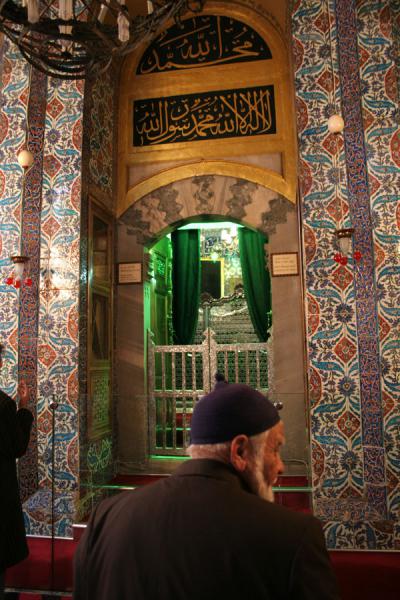
Abu Ayyub al-Ansari
Abu Ayyub al-Ansari (576?–674?) - born Khalid ibn Zayd ibn Kulayb in Yathrib - hailed from the tribe of Banu Najjar and was a close companion (Arabic: الصحابه, sahaba) of Prophet Muhammad, PBUH. Abu Ayyub was one among the Ansar (Arabic: الأنصار, meaning aiders, helpers or patrons) of early Muslim history, or those who supported Muhammad, PBUH after the hijra (migration) to Medina in 622 C.E. The patronym Abu Ayyub, means father (abu) of Ayyub.
When Muhammad, PBUH arrived in Medina he was extended accommodations by all of its inhabitants, but he wished to stay with the Banu Najjar, whom he was distantly related to. Upon making inquiries as to the member of Banu Najjar closest to him, Muhammad, PBUH was introduced to Abu Ayyub al-Ansari, who was granted the honor of temporarily lodging Muhammad, PBUH for seven months.
Following the Muslim conquest of Egypt Abu Ayyub moved to a house in Fustat adjacent to the mosque of Amr bin Al'aas which was completed in 642 CE. Several other notable Companions were his neighbors, including Zubayr ibn al-Awwam, Ubaida, Abu Zar, Abdullah ibn Umar and Abdullah ibn Amr bin Al'aas.
He also led a distinguished military career. Of him it was said, He did not stay away from any battle the Muslims fought from the time of Muhammad, PBUH to the time of Muawiyah unless he was engaged at the same time in another.
Last military campaign
Muhammad ibn Jarir al-Tabari records under A.H. 49 (9/2/669-28/1/670) a number of raids against the Byzantines, including the one led by Muawiyah's son Yazid against Constantinople (cf. Siege of Constantinople (674)). Abu Ayyub is among the notables listed as accompanying Yazid. He was an old man, but that did not prevent him from enlisting. After a short time engaged in battle, he fell ill and had to withdraw. Yazid came to him and asked: "Do you need anything, Abu Ayyub?" To which Abu Ayyub replied, "Convey my salaams (Islamic farewell) to the Muslim armies and tell them: "Abu Ayyub urges you to penetrate deeply into the territory of the enemy as far as you can go, that you should carry him with you and that you should bury him under your feet at the walls of Constantinople." Then he breathed his last. The Muslim army fulfilled his request and pushed back the enemy's forces until they reached the walls of Constantinople where Abu Ayyub was buried.
About this battle, Aslam-ibn `Imran narrated that when they were fighting the Romans, a Muslim soldier penetrated the enemy ranks. People shouted, "Subhan allah! He has contributed to his own destruction." Some say that thereupon, Abu Ayyub al-Ansari stood up, and said, "O people! You give this interpretation to this verse, whereas it was revealed concerning us, the Ansar, when actually Allah had given honour to Islam and its supporters had become many, whereupon some of us secretly said to one another ... 'Our wealth has been depleted, and Allah has given honour to Islam and its supporters have become many, so let us stay amidst our wealth and make up what has been depleted of it.' Thereupon, Muslims believe God said to Muhammad, 'And spend in the Path of God ( فِي سَبِيلِ اللّهِ ), and do not contribute to your own destruction'... refuting what we had said. So, the destruction lay in staying with our wealth and repleting it and abandoning combat."
The tomb of Abu Ayyub al-Ansari
The tomb of Abu Ayyub al-Ansari (Eyüp Sultan Türbesi) has always been a center of attraction, drawing a variety of people, including Ottoman sultans, throughout its history. Today, it remains the district’s nucleus and holds a special place in people’s hearts.
Abu Ayyub al-Ansari still beckons thousands of people. Farmers from Anatolia, businessmen, statesmen, intellectuals, students, women from the countryside in their colorful local dress and foreigners all come to pay their respect, to recite verses of the Quran, to ask for the Creator’s blessing or simply to breathe the spiritual air radiating from area. For many people who come to visit İstanbul for whatever reason, Eyüp is a must see.
The number of visitors to the mosque and the tomb increases significantly during religious holidays, Friday prayers and the holy month of Ramadan in particular. Streets become overcrowded due to traffic during Ramadan, but despite having to wait in traffic for hours, they keep on coming.
It is also a common tradition among newlyweds to visit the tomb as well as the mosque and for families to bring their sons to celebrate their circumcision.
Mehmet II had the tomb built in 1459 after his spiritual mentor, Akshemsettin, saw the burial site in a dream. A plane tree beside which al-Ansari’s body was discovered still stands in the middle of the inner courtyard of the Eyüp Sultan Mosque.
The outer and inner walls of the tomb are adorned with tiles. The single-domed tomb has an octagonal shape. That part of the tomb housing Abu Ayyub al-Ansari’s sarcophagus, enclosed in silver with beautifully adorned railings, is separated from the rest of the hall. The velvet curtains at the tomb are said to have been originally made for the shrine of the Prophet Mohammed, known as Rawdat-ul-Mutahhara (Dome of the Prophet); nevertheless the curtains could not be sent there due to the outbreak of World War I and were hung in Abu Ayyub al-Ansari’s tomb instead.
The mausoleum hall and the tomb chamber have been adorned with calligraphy, crystal chandeliers and silver decorations from different centuries. Furthermore, a footprint of the Prophet Mohammed in marble stone and framed in silver lays embedded in the wall that faces the direction of prayer.
Saya juga baca artikel kakak mengenai :
ReplyDeletecelana hernia magnetik
obat pemutih gigi white care
obat asam urat tradisional
obat wasir
jual obat herbal
obat pelangsing murah
vimax canada original
jual game pc